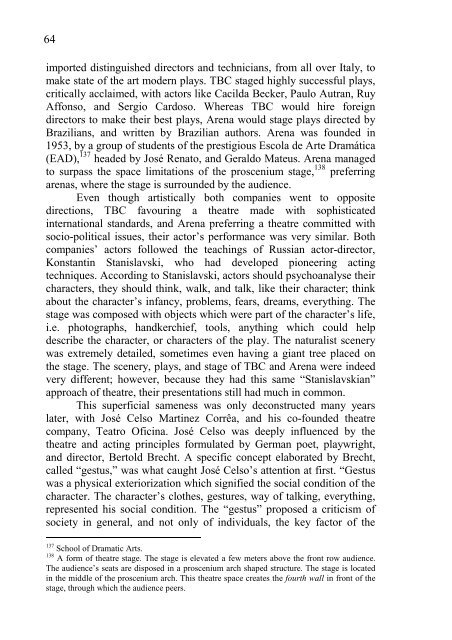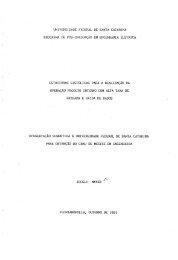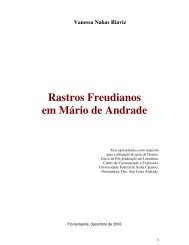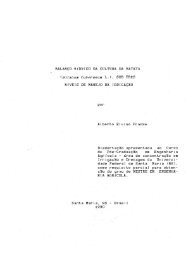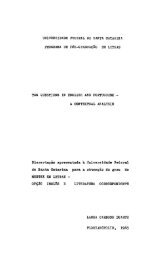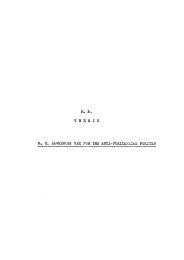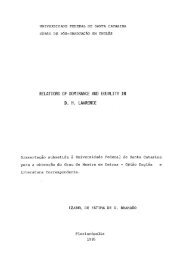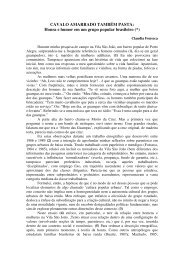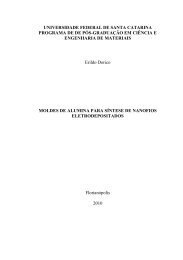Tropical ginsberg
Tropical ginsberg
Tropical ginsberg
Create successful ePaper yourself
Turn your PDF publications into a flip-book with our unique Google optimized e-Paper software.
64<br />
imported distinguished directors and technicians, from all over Italy, to<br />
make state of the art modern plays. TBC staged highly successful plays,<br />
critically acclaimed, with actors like Cacilda Becker, Paulo Autran, Ruy<br />
Affonso, and Sergio Cardoso. Whereas TBC would hire foreign<br />
directors to make their best plays, Arena would stage plays directed by<br />
Brazilians, and written by Brazilian authors. Arena was founded in<br />
1953, by a group of students of the prestigious Escola de Arte Dramática<br />
(EAD), 137 headed by José Renato, and Geraldo Mateus. Arena managed<br />
to surpass the space limitations of the proscenium stage, 138 preferring<br />
arenas, where the stage is surrounded by the audience.<br />
Even though artistically both companies went to opposite<br />
directions, TBC favouring a theatre made with sophisticated<br />
international standards, and Arena preferring a theatre committed with<br />
socio-political issues, their actor’s performance was very similar. Both<br />
companies’ actors followed the teachings of Russian actor-director,<br />
Konstantin Stanislavski, who had developed pioneering acting<br />
techniques. According to Stanislavski, actors should psychoanalyse their<br />
characters, they should think, walk, and talk, like their character; think<br />
about the character’s infancy, problems, fears, dreams, everything. The<br />
stage was composed with objects which were part of the character’s life,<br />
i.e. photographs, handkerchief, tools, anything which could help<br />
describe the character, or characters of the play. The naturalist scenery<br />
was extremely detailed, sometimes even having a giant tree placed on<br />
the stage. The scenery, plays, and stage of TBC and Arena were indeed<br />
very different; however, because they had this same “Stanislavskian”<br />
approach of theatre, their presentations still had much in common.<br />
This superficial sameness was only deconstructed many years<br />
later, with José Celso Martinez Corrêa, and his co-founded theatre<br />
company, Teatro Oficina. José Celso was deeply influenced by the<br />
theatre and acting principles formulated by German poet, playwright,<br />
and director, Bertold Brecht. A specific concept elaborated by Brecht,<br />
called “gestus,” was what caught José Celso’s attention at first. “Gestus<br />
was a physical exteriorization which signified the social condition of the<br />
character. The character’s clothes, gestures, way of talking, everything,<br />
represented his social condition. The “gestus” proposed a criticism of<br />
society in general, and not only of individuals, the key factor of the<br />
137 School of Dramatic Arts.<br />
138 A form of theatre stage. The stage is elevated a few meters above the front row audience.<br />
The audience’s seats are disposed in a proscenium arch shaped structure. The stage is located<br />
in the middle of the proscenium arch. This theatre space creates the fourth wall in front of the<br />
stage, through which the audience peers.


